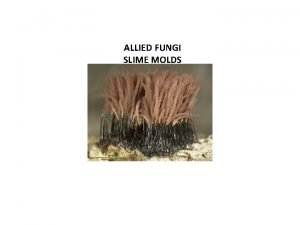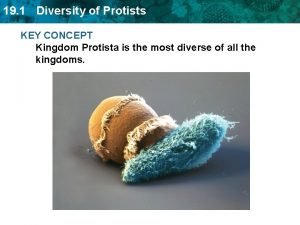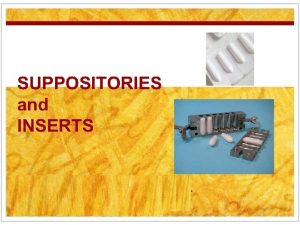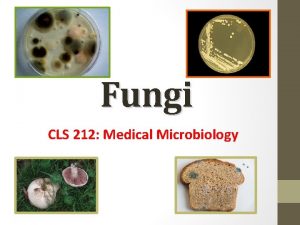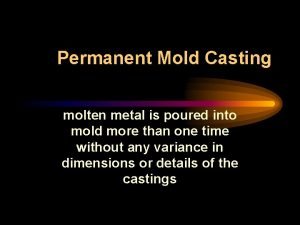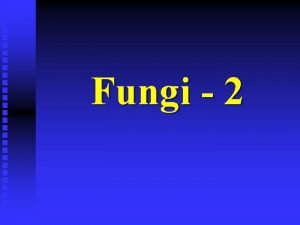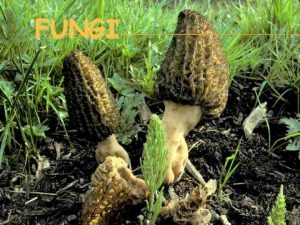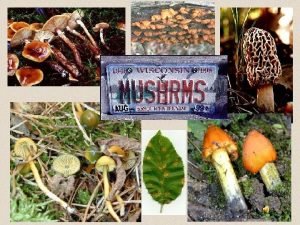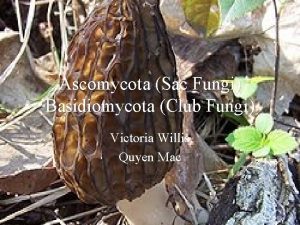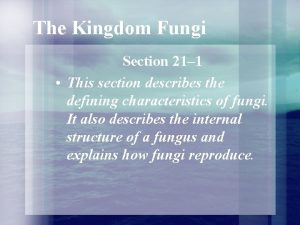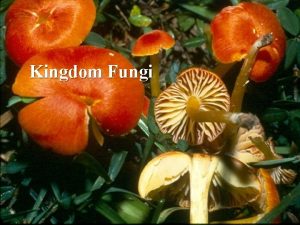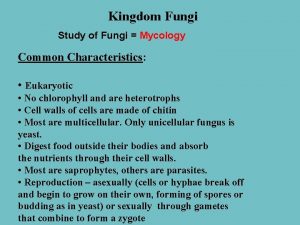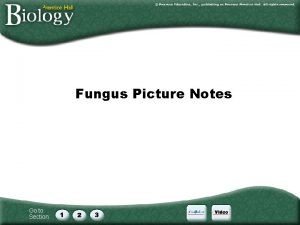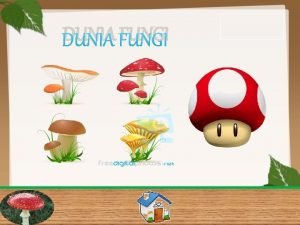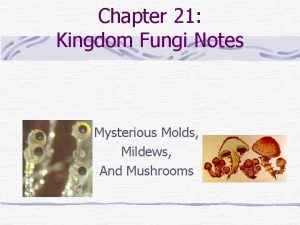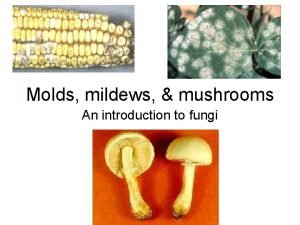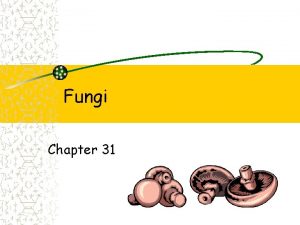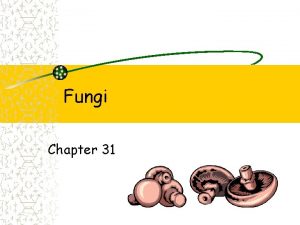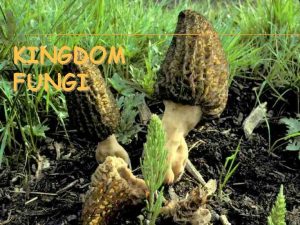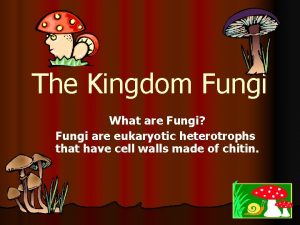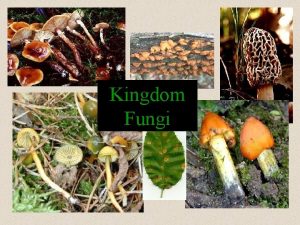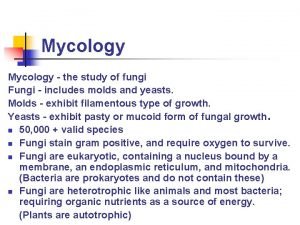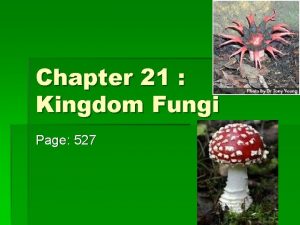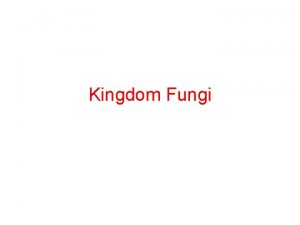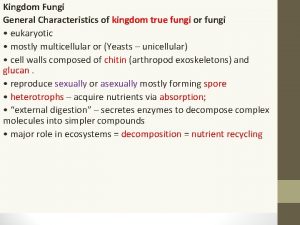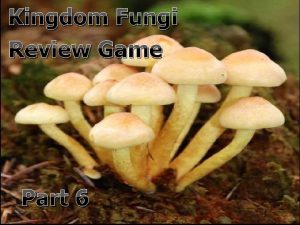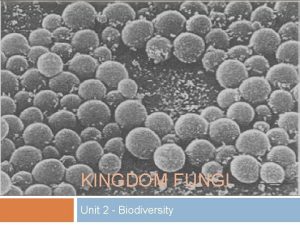Chapter 21 Kingdom Fungi Notes Mysterious Molds Mildews
































- Slides: 32

Chapter 21: Kingdom Fungi Notes Mysterious Molds, Mildews, And Mushrooms

What do we already know about Fungi? • From our Classification unit, we should already know many things about fungi – Eukaryote or prokaryote? – Unicellular or multicellular? – Cell wall or not? • What is it made of? – Autotroph or heterotroph? – Kingdom:

Characteristics of members of the Kingdom Fungi: 1. __________________ 2. ____________________________________ 3. __________________ Penicillium

Characteristics of members of the Kingdom Fungi: 4. are NOT plants because a. _______________________________________ b. Fungi are heterotrophs: They do not make their own food and must obtain food from the organisms or materials on which they live. Fungi are decomposers.

Multicellular fungi are composed of: 1. Thin filaments called hyphae tangled together into a mass called mycelium. Nuclei Cell wall Cytoplasm Cross wall Hyphae With Cross Walls Cytoplasm Nuclei Cell wall Hyphae Without Cross Walls 2. A fruiting body, the reproductive structure (like the part of the mushroom that you see above ground).

Club Fungus __________________

Fungi Reproduction 1. In their life cycle, most fungi reproduce both sexually and asexually. 2. They can produce spores that can spread (think of them like fungus seeds) and grow into a new fungus.

Types of Fungi Common Name: ____________ Phylum: ________________ Characteristics Can grow on foods such as meat, cheese, and bread. They appear fuzzy and can be different colors.

Characteristics: Reproduce asexually by producing haploid spores on the sporangium atop long supportive hyphae called a sporangiophore. Example: • _______________________ • ____________

Figure 21 -5 The Life Cycle of Rhizopus Section 21 -2 Zygospore (2 N) FERTILIZATION Sporangium Gametangia MEIOSIS Sporangium Spores (N) Zygospore (2 N) Spores (N) Stolons + Mating type (N) - Mating type (N) Sporangiophore Asexual Reproduction Rhizoids Sexual Reproduction Diploid Haploid

Types of Fungi Common Name: _________________ Phylum: _____________________ Characteristics: • In a moist, warm, anaerobic (without oxygen) environment, yeast will rapidly divide and perform alcoholic fermentation. • Saccharomyces in the presence of sugar will perform alcoholic fermentation converting sugar into carbon dioxide and alcohol. • This is what makes bread rise (CO 2 makes the “holes” in the bread, and the alcohol evaporates) and alcoholic beverages alcoholic (alcohol stays there and CO 2 make beverages bubble)

More Sac Fungi Phylum: Ascomycota Example: • ________________

More Sac Fungi Common Name: ___________ Example: morels, truffles Morels Yeast Truffle s

Figure 21 -7 The Life Cycle of an Ascomycete Section 21 -2 Fruiting body (N + N) Hyphae (N + N) Ascus (N + N) Diploid Zygote (2 N) Haploid Hyphae (N) Gametangia Asci FERTILIZATION HYPHAE FUSE + Mating type (N) - Mating type (N) MEIOSIS Sexual Reproduction Ascus Conidia (N) Hypha (N) Conidiophore Hypha (N) Asexual Reproduction 8 Ascospores (N)

Types of Fungi Common Name: ____________ Phylum: _______________ Characteristics: The fruiting body resembles a club, that has basidia (spore-bearing part) on the underside of the club part.

Figure 21 -8 The Life Cycle of a Basidiomycete Section 21 -2 Fruiting body (N + N) Gills lined with basidia Gills Cap Button Stalk Base Basidia (N + N) Secondary mycelium (N + N) FERTILIZATION HYPHAE FUSE Primary mycelium (N) Zygote (2 N) - Mating type (N) Haploid Diploid + Mating type (N) MEIOSIS Basidiospores (N)

More on Club Fungi are the ones we eat, but most are poisonous. ________________ _______________ Examples: Mushrooms, puffballs

Types of Fungi Common Name: __________ Phylum: _____________ Characteristics: They do not appear to go through a sexual reproductive stage. *Includes all the fungi that scientists cannot place into the other phyla because they have never observed a sexual phase in the life cycle.

More on Imperfect Fungi Common Name: Imperfect Fungi Example: Penicillium is a mold that grows on fruit- it is the source of penicillin (an antibiotic).

Diverse Roles of Fungi • Fungi are not all gross (like we sometimes assume) • What do we already know about fungi and their niche (role in the ecosystem) – What are some good fungi? – What are some bad fungi?

Diverse roles of fungi 1. _______________ a. Plant pathogens: smut and rusts Corn smut Rust fungi Melamspora

Diverse roles of fungi Animal pathogens: i. Some species can kill insects and use their body as food (see page 539) Planet Earth time: 27: 00

Diverse roles of fungi ii. Fungi known as dermatophytes cause athlete’s foot, jock itch, and ringworm **The fungus forms a mycelium within the outer layers of the skin.

Diverse roles of fungi iii. The fungus Candida albicans causes thrush (mouth infection), diaper rash, and yeast infections in the female reproductive tract.

Diverse roles of fungi 2. ______________ breaking down dead material & returning the organic material to the soil.

Diverse roles of fungi 3. _______________: mushrooms, bleu cheese, production of soy sauce Edible mushrooms Soy sauce

Diverse roles of fungi 4. ________________: can cause destruction of cells and organ failure, neurological symptoms, and gastrointestinal irritation “Angel of Death” Amanita Muscaria

Diverse roles of fungi 5. _________________ a. ____________: toxin produced by the mold Penicillium notatum kills some bacteria by interfering with their ability to synthesize the cell wall.

Penicillium produces a substance that is toxic to some bacteria- discovered by Alexander Fleming in 1928. penicillin bacteria

Diverse roles of fungi b. __________________: an immunosuppressant drug widely used in organ transplant patients to reduce the activity of the patient's immune system to decrease the risk of organ rejection. Tolypocladium inflatum Cyclosporine

Diverse roles of fungi 6. ____________________________________ a. Lichens: Lichens are not a single organism, but rather a combination of two organisms, an alga and a fungus. i. The alga provides energy by photosynthesis and the fungus provides water and minerals to the algae.

Diverse roles of fungi b. _________________ are plant roots entangled with fungal hyphae. The fungus releases nutrients from the soil and aids in the absorption of water by the plant roots, and the plant provides energy by photosynthesis to the fungus.
 Molds kingdom
Molds kingdom Protista mobility
Protista mobility Kingdom plantae characteristics
Kingdom plantae characteristics Domain eukarya kingdom fungi
Domain eukarya kingdom fungi Old kingdom middle kingdom new kingdom
Old kingdom middle kingdom new kingdom Nnn ruled
Nnn ruled Youtube egypt
Youtube egypt Old kingdom middle kingdom new kingdom
Old kingdom middle kingdom new kingdom Plasmodial slime mold vs cellular slime mold
Plasmodial slime mold vs cellular slime mold Cellular vs plasmodial slime molds
Cellular vs plasmodial slime molds General characteristics of allied fungi
General characteristics of allied fungi Animal like protists
Animal like protists Miscellaneous base for suppositories
Miscellaneous base for suppositories How to make slip casting molds
How to make slip casting molds Blow moulding advantages
Blow moulding advantages Superficial mycosis
Superficial mycosis Custom molds inc
Custom molds inc The process of pouring molten metal into molds
The process of pouring molten metal into molds Fungi2u.com
Fungi2u.com Haustorium in fungi
Haustorium in fungi Club fungi are morels truffles bracket fungi yeast
Club fungi are morels truffles bracket fungi yeast Basidiomycota and ascomycota
Basidiomycota and ascomycota Short story about a mysterious box
Short story about a mysterious box Folkways
Folkways Mysterious ziggy
Mysterious ziggy What is the main function of a fungus’s hyphae?
What is the main function of a fungus’s hyphae? Kingdom fungi characteristics
Kingdom fungi characteristics Fungal cell walls are characteristic in having
Fungal cell walls are characteristic in having What characteristics define a fungus
What characteristics define a fungus Kingdom fungi concept map
Kingdom fungi concept map Domain for fungi
Domain for fungi Peta konsep klasifikasi fungi
Peta konsep klasifikasi fungi Protista, fungi, plantae, animalia *
Protista, fungi, plantae, animalia *










